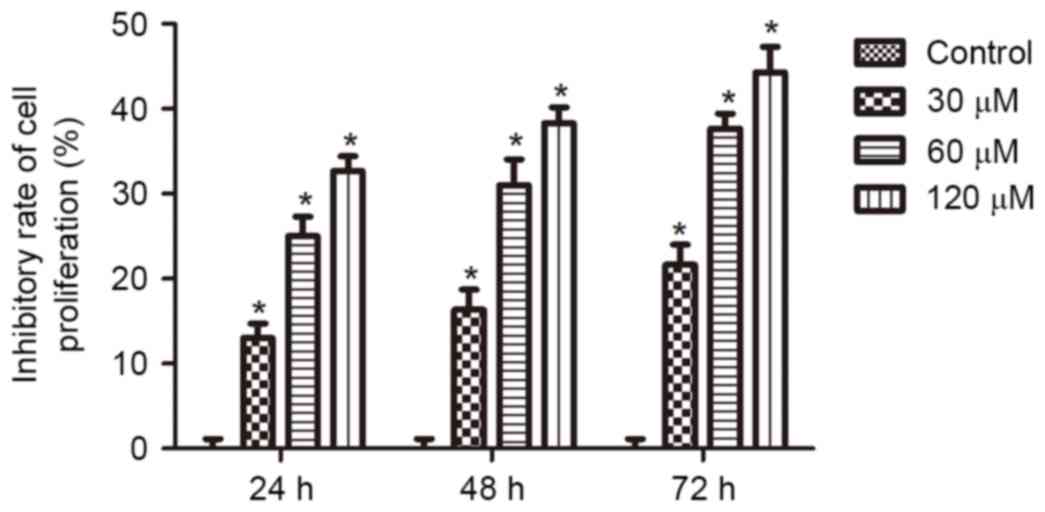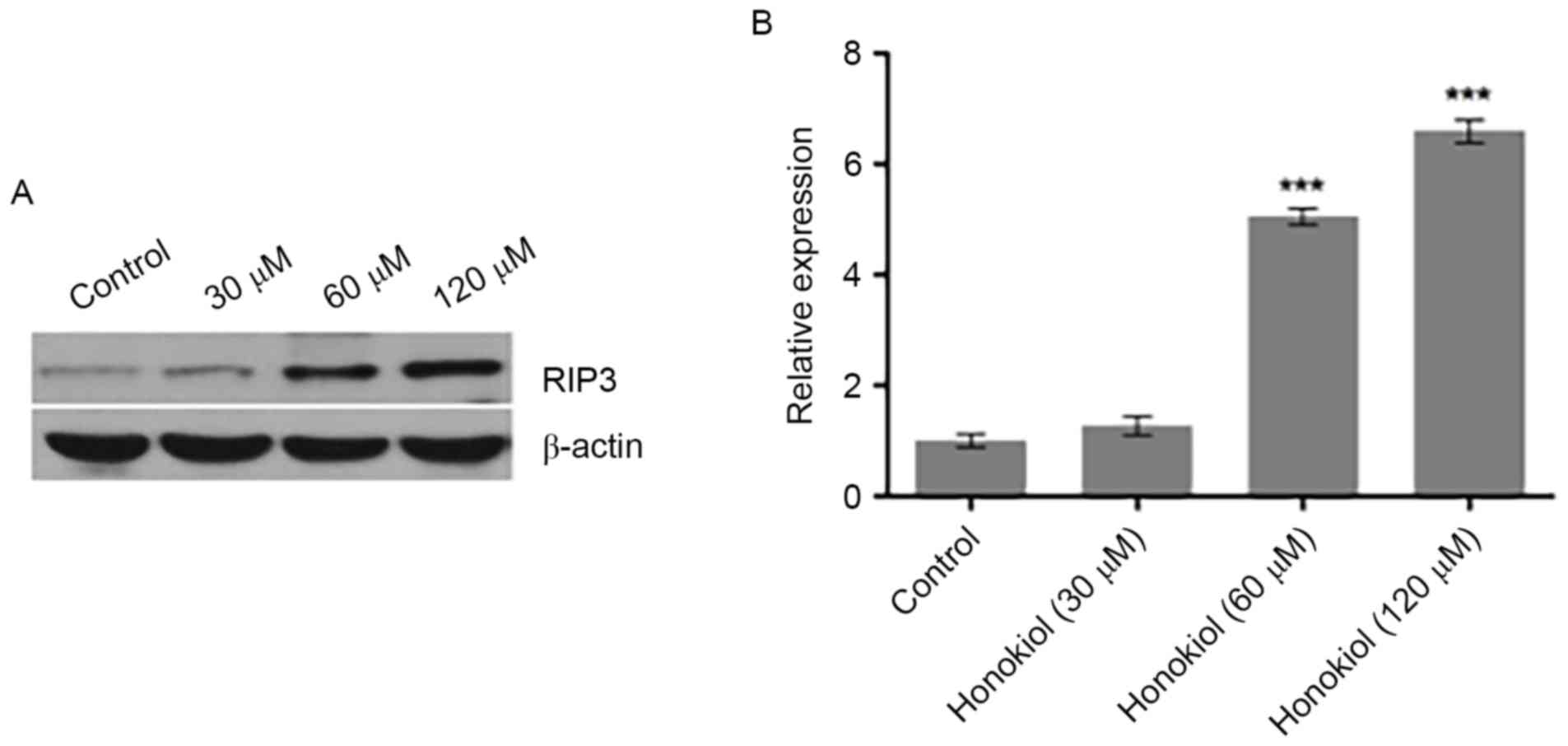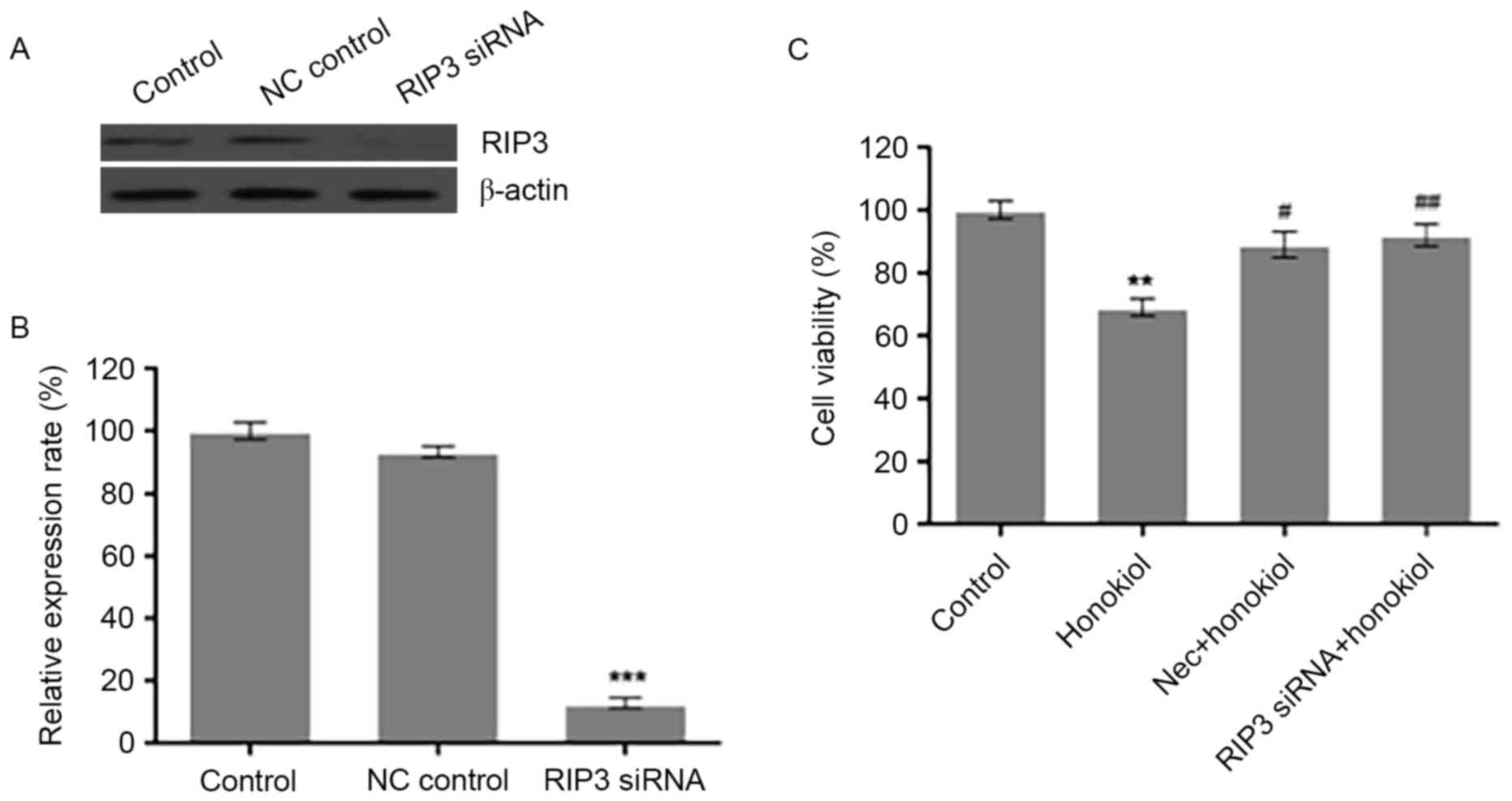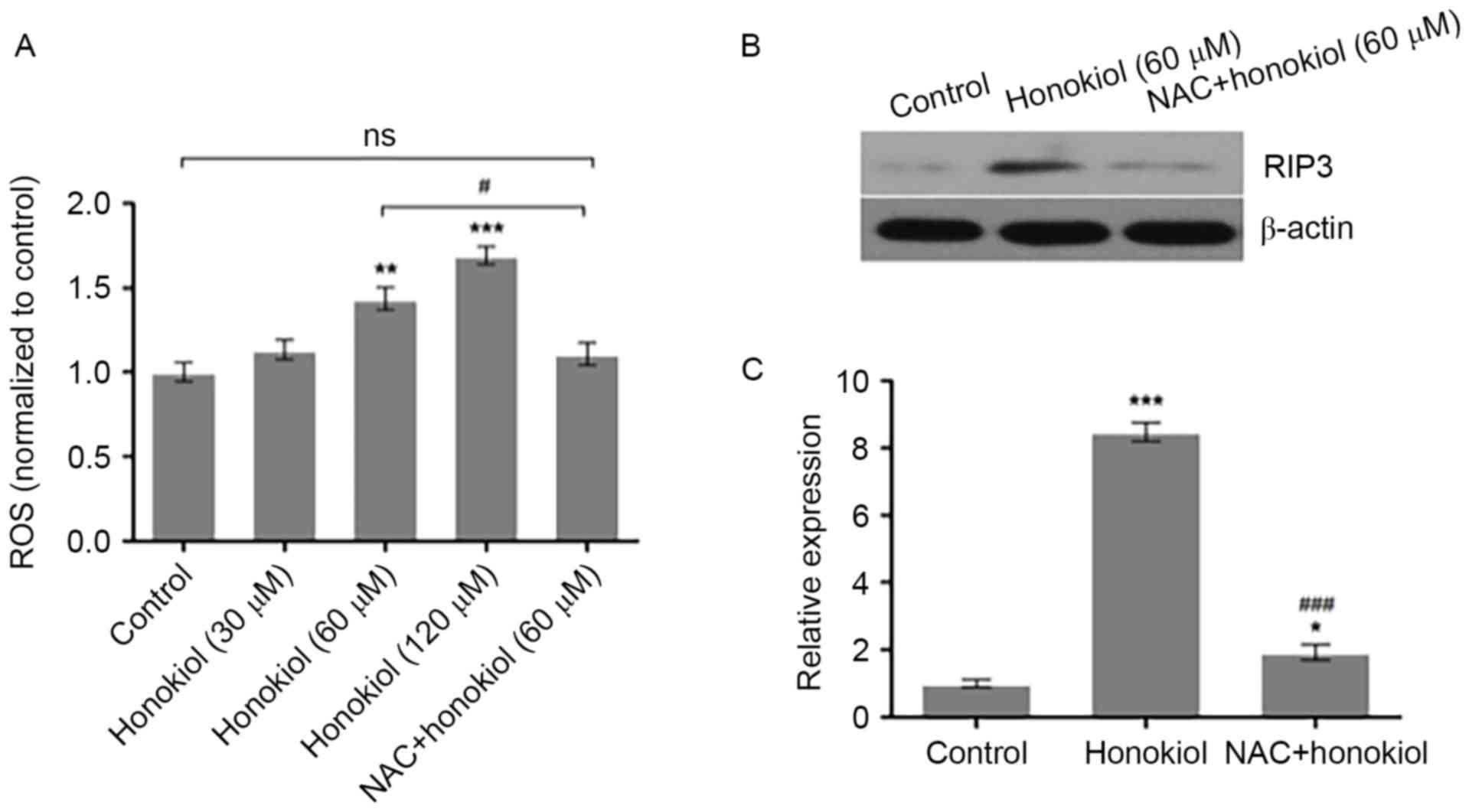Honokiol triggers receptor‑interacting protein kinase 3‑mediated cell death of neuroblastoma cells by upregulating reactive oxygen species
- Authors:
- Published online on: September 26, 2017 https://doi.org/10.3892/mmr.2017.7628
- Pages: 8525-8529
Abstract
Introduction
Neuroblastoma originates from the neural crest of the sympathetic nervous system (1), and is the most common solid tumor in children in terms of incidence and also mortality, with 800 new cases diagnosed each year in the United States (2). Almost half of patients with neuroblastoma are children younger than two years old, with a median age of 17 months at diagnosis. Neuroblastoma accounts for 8–10% of all pediatric malignant tumors and 15% of cancer-associated death in children (3–5). Patients with neuroblastoma are usually treated with a combination of chemotherapy, surgery and radiation (6). However, the majority of patients will develop certain complications, including infertility, hearing loss and cardiac dysfunction, following these procedures (7). In 2015, the molecular-targeted drug dinutuximab, in combination with granulocyte macrophage colony-stimulating factor, interleukin-2 and isotretinoin, was approved as treatment for high-risk neuroblastoma, however, various serious adverse reactions, which include infusion reactions and neuropathy, have been reported to be associated with this treatment regimen (8). Therefore, it is of high importance to identify and develop treatments for neuroblastoma that exhibit increased potency and reduced side effects.
Honokiol [2-(4-hydroxy-3-prop-2-enyl-phenyl)-4-prop-2-enylphenol] is a soluble, nontoxic, natural small-molecule polyphenol from the magnolia plant. It has been reported to inhibit thegrowth of various types of cancer cells (9), including oral squamous cell carcinoma (10), glioblastoma multiforme (11), human prostate cancer (12) and melanoma cells (13). A previous report also demonstrated that honokiol kills neuroblastoma cells (14), indicating that honokiol may be a promising agent for neuroblastoma treatment. However, the molecular pharmacology of honokiol in the suppression of cancer cell growth and proliferation is largely unknown.
The present study treated the Neuro-2a mouse neuroblastoma cell line with honokiol and demonstrated that honokiol inhibited the growth of Neuro-2a cells in a time- and dose-dependent manner. Further mechanistic investigation revealed that honokiol triggered receptor-interacting protein kinase 3 (RIP3)-mediated loss of cell viability in neuroblastoma cells via the generation of reactive oxygen species (ROS).
Materials and methods
Reagents
Honokiol and MTT were purchased from Sigma-Aldrich (Merck KGaA, Darmstadt, Germany). Necrosulfonamide (Nec) was from Abcam (Cambridge, MA, USA). N-acetyl-L-cysteine (NAC) and Lipofectamine 2000 were obtained from Invitrogen (Thermo Fisher Scientific, Inc., Waltham, MA, USA). RIP3 small interfering (si)RNA (5′-CCAGAGACCUCAACUUUCA-3′) and control siRNA (5′-UUCUCCGAACGUGUCACGUTT-3′) were purchased from Qiagen, Inc. (Valencia, CA, USA). Rabbit anti-RIP3 (#95702) and β-actin antibodies (#8457) were purchased from Cell Signaling Technology, Inc. (Danvers, MA, USA).
Cell culture and treatments
Neuro-2a mouse neuroblastoma cells were obtained from the American Type Culture Collection (Manassas, VA, USA). Cells were grown in Dulbecco's modified Eagle's medium (Thermo Fisher Scientific, Inc.) supplemented with 10% (v/v) heat-inactivated fetal bovine serum (Thermo Fisher Scientific, Inc.), 2 mM L-glutamine, 100 IU/ml penicillin and 100 µg/ml streptomycin in an incubator at 37°C with 5% CO2. Transfection of 100 nM siRNA with Lipofectamine 2000 was performed according to the manufacturer's protocol. Neuro-2a cells were treated with 60 µM honokiol alone, or in combination with 100 nM RIP3 siRNA for 24 h or with 1 µM RIP3 specific inhibitor Nec for 48 h. For the ROS scavenger assay, Neuro-2a cells were treated with vehicle, 60 µM honokiol or a combination of 1 µM NAC and 60 µM honokiol for 48 h. Control cells were treated with DMSO instead of honokiol throughout the study.
MTT assay
The cytotoxicity of honokiol in Neuro-2a cells was determined using an MTT colorimetric assay. Briefly, Neuro-2a cells were seeded in 200 µl at a concentration of 1×104 cells/well in 96-well tissue culture plates and incubated at 37°C with 5% CO2. The next day, cells were treated with 0, 30, 60 or 120 µM honokiol for 24, 48 and 72 h. Following incubation, 20 µl MTT reagent (5 mg/ml) was added to each well and incubated for another 3 h. MTT solution was removed and dimethylsulfoxide was added to each well to dissolve the blue formazan product. The absorbance at 550 nm was recorded. The relative inhibition rate of the cells was calculated according to the following equation: Relative inhibition rate of cells = (1 - absorbance value of sample) / (absorbance value of control) × 100. Data were calculated from three independent experiments.
Western blot analysis
Total proteins were extracted from 2×106 cultured cells using radioimmunoprecipitation assay lysis buffer (1% Nonidet P-40, 0.5% sodium deoxycholate and 0.1% SDS in 1X phosphate buffer solution) containing protease inhibitors (2 µg/ml aprotinin, 2 µg/ml leupeptin and 1 mM phenylmethylsulfonyl fluoride) for 30 min on ice. Following centrifugation at 12,000 × g for 15 min at 4°C, the supernatant was resuspended in buffer containing 1% SDS and 1% dithiothreitol, and heated at 100°C for 5 min. The protein concentration was quantified using a bicinchoninic acid protein assay, and an equal amount of protein (20 µg) was electrophoresed by 10% SDS-PAGE and transferred onto nitrocellulose membranes. Following blocking with 5% non-fat dry milk in TBS-Tween-20 (TBS-T; 10 mM Tris-HCl, pH 8.0, 100 mM NaCl and 0.05% Tween-20) at room temperature for 1 h, the membrane was incubated at 4°C overnight with rabbit anti-RIP3 (1:1,000; #95702) or anti-β-actin (1:1,000; #8457) primary antibodies (both from Cell Signaling Technology, Inc.). Following incubation, the membrane was washed twice with TBS-T for 15 min and incubated with horseradish peroxidase-conjugated goat anti-rabbit secondary antibody (Abcam, ab6721, 1:5,000) at room temperature for 1 h. After washing with TBS-T, the immunoreactivities were visualized by an ECL plus chemiluminescence kit (Beyotime Institute of Biotechnology, Haimen, China) according to manufacturer's protocol (Pierce; Thermo Fisher Scientific, Inc.). The relative optical density of bands were analyzed using Image-Pro Plus 6.0 software (Media Cybernetics, Inc., Rockville, MD, USA).
Measurement of intracellular ROS
Levels of ROS were measured using the ROS assay kit from Beyotime Institute of Biotechnology, according to the manufacturer's protocol. Briefly, following treatment, 1×106 Neuro-2a cells were incubated with 10 µM non-fluorescent probe 2′,7′-dichlorofluorescin diacetate (DCFH-DA) for 20 min at room temperature. DCFH-DA is able to penetrate the cellular membrane and be hydrolyzed to dichlorofluorescin (DCFH) carboxylate anion. DCFH is subsequently oxidized by ROS, which results in the formation of fluorescent dichlorofluorescein (DCF). DCF fluorescence was detected using fluorescence spectroscopy with maximum excitation and emission of 495 and 529 nm, respectively.
Statistical analysis
All statistical analyses were performed using GraphPad Prism 5.0 (GraphPad Software, Inc., La Jolla, CA, USA). Data are presented as the mean ± standard error of the mean. One-way analysis of variance was used to compare differences among three or more groups, which was followed by Bonferroni post-hoc testing for multiple comparisons. P<0.05 was considered to indicate a statistically significant difference.
Results
Honokiol inhibits the proliferation of Neuro-2a mouse neuroblastoma cells in a time- and dose-dependent manner
To assess the effects of honokiol on the growth of neuroblastoma cells, Neuro-2a cells were treated with 0, 30, 60 or 120 µM honokiol for 24, 48 and 72 h. Cell viability was assessed by MTT assay. As demonstrated in Fig. 1, following treatment for 24 h, 30, 60 and 120 µM honokiol resulted in inhibition of cell proliferation by 12, 25 and 30%. Furthermore, increased inhibitory effects were observed when the treatment time was extended to 48 and 72 h. These results demonstrate that honokiol inhibited the growth of Neuro-2a cells in a time- and dose-dependent manner.
Honokiol promotes the expression of RIP3 in Neuro-2a neuroblastoma cells
Necrosis is the process of cell death caused by various external factors, including toxins, infections and trauma, or induced by specific genes in a regulated manner (15). RIP3 has an essential role in the necrosis pathway (16) and a recent study reported that stress induced RIP3 upregulation in neuroblastoma cells (17). To investigate the mechanism and potential role of RIP3 in the suppression of neuroblastoma cell proliferation by honokiol, the protein expression of RIP3 in Neuro-2a cells was investigated using western blot analysis following treatment of cells with various concentrations (0, 30, 60 and 120 µM) of honokiol for 48 h. Compared with the untreated control, 30 µM marginally increased RIP3 protein expression, while 60 and 120 µM honokiol significantly increased the protein expression of RIP3 (Fig. 2). These results indicate that honokiol promoted the expression of RIP3 in Neuro-2a neuroblastoma cells.
Silencing RIP3 by siRNA or pharmacological inhibition of RIP3 prevents honokiol-induced loss of cell viability in Neuro-2a neuroblastoma cells
The observed induction of RIP3 indicates that RIP3 may have an important role in honokiol-mediated necrosis of Neuro-2a cells. To test this hypothesis, the present study knocked down RIP3 in Neuro-2a cells by siRNA. Compared with scrambled control siRNA (NC control), transfection of 100 nM RIP3 siRNA reduced the protein expression of RIP3 in Neuro-2a cells (Fig. 3A). Analysis of the relative optical density of RIP3 bands demonstrated that RIP3 siRNA significantly decreased the protein level of RIP3 (Fig. 3B), compared with the control. Neuro-2a cells were also treated with 60 µM honokiol alone, or in combination with RIP3 siRNA transfection for 24 h or treatment with 1 µM RIP3 specific inhibitor Nec for 48 h (Fig. 3C). Cell viability was assessed by MTT assay. Compared with the control group, 60 µM honokiol significantly reduced the cell viability of Neuro-2a cells, which was significantly reversed by Nec and RIP3 siRNA treatments (Fig. 3C). These results indicate that induction of RIP3 contributed to the observed honokiol-mediated loss of cell viability in Neuro-2a cells.
Honokiol inhibits Neuro-2a neuroblastoma cell growth via ROS-mediated upregulation of RIP3
To investigate whether honokiol inhibits Neuro-2a neuroblastoma cell growth via ROS-mediated upregulation of RIP3, Neuro-2a cells were treated with vehicle, honokiol (30, 60 and 120 µM) or a combination of ROS scavenger NAC (1 µM) and honokiol (60 µM) for 48 h. The intracellular ROS levels were measured using DCFH-DA. Compared with the vehicle control, 60 and 120 µM honokiol significantly increased the intracellular ROS levels, while NAC treatment significantly prevented the induction of ROS by honokiol (Fig. 4A). In addition, Neuro-2a cells were treated with vehicle, 60 µM honokiol or a combination of 1 µM NAC and 60 µM honokiol for 48 h, and the protein expression of RIP3 was determined by western blot analysis. As demonstrated in Fig. 4B, the 60 µM honokiol-induced increase of RIP3 protein expression was reversed to a certain extent by NAC. Analysis of the relative optical density of RIP3 bands demonstrated that 60 µM honokiol significantly increased the protein expression of RIP3, compared with the control group, which was significantly prevented by NAC (Fig. 4C). These results indicate that honokiol may suppress Neuro-2a neuroblastoma cell growth, at least partially, through ROS-mediated upregulation of RIP3.
Discussion
Honokiol has been demonstrated to inhibit the growth of various types of cancer cells (9–14). However, the molecular mechanism of honokiol in the suppression of cancer cell growth and proliferation is largely unknown. The present study demonstrated that honokiol inhibited the growth of Neuro-2a neuroblastoma cells in a time- and dose-dependent manner, which was accompanied by upregulation of RIP3. Furthermore, silencing RIP3 by siRNA or pharmacological inhibition of RIP3 reversed honokiol-induced loss of cell viability in Neuro-2a cells. Importantly, honokiol significantly increased the intracellular ROS levels and the expression of RIP3, while the ROS scavenger NAC significantly prevented the induction of ROS and RIP3 by honokiol. These results indicate that honokiol may trigger RIP3-mediated loss of cell viability in neuroblastoma cells via the generation of ROS.
Honokiol has been demonstrated to inhibit the growth of human glioma via multiple mechanisms. Honokiol was reported to suppress human glioma growth via induction of apoptosis and cell cycle arrest in tumor cells by activating a p53/cyclin D1/cyclin dependent kinase (CDK) 6/CDK4/E2F transcription factor 1-dependent pathway (18). Notably, honokiol was also reported to induce autophagy in neuroblastoma cells via the phosphatidylinositol 3-kinase/Akt/mechanistic target of rapamycin and endoplasmic reticulum stress/ROS/extracellular signal-regulated kinase 1/2 signaling pathways, and the suppression of cell migration (19). In addition, necrosis is the process of cell death that is caused by certain external factors, which include toxins, infections and trauma, or induced by specific genes in a regulated manner (15). The results of the present study indicated that honokiol induced the expression of RIP3, which is upregulated by stress in neuroblastoma cells and has an essential role in necrosis (16–17). Furthermore, silencing RIP3 by siRNA or pharmacological inhibition of RIP3 reversed honokiol-induced loss of cell viability in Neuro-2a cells. The current study has identified an additional mechanism by which honokiol induces loss of cell viability in neuroblastoma cells, indicating that honokiol may be a potential candidate drug for treating brain tumors such as neuroblastoma.
It was reported that honokiol inhibited the growth of malignant glioma via ROS (20). Furthermore, it has been reported that ROS inhibited RIP protein-induced necroptosis of MiaPaCa-2 and BxPC-3 cells (21). These advances led us to hypothesize that honokiol may suppress neuroblastoma cell growth via ROS-mediated upregulation of RIP3. Indeed, the present study revealed that honokiol significantly increased the intracellular ROS levels and the protein expression of RIP3, while the ROS scavenger NAC significantly prevented the induction of ROS and RIP3 expression by honokiol. These results indicate that honokiol may stimulate the expression of RIP3, at least partially, through the production of ROS in neuroblastoma cells.
In conclusion, the present study demonstrated that honokiol inhibited cell proliferation, promoted the production of ROS and stimulated the protein expression of RIP3 in Neuro-2a mouse neuroblastoma cells. The results of the current study indicate that honokiol may suppress neuroblastoma cell growth via ROS-mediated upregulation of RIP3, providing the basis for further development of honokiol for the treatment of neuroblastoma.
Acknowledgements
This work was supported by the National Natural Science Fund of China (grant no. 81502187).
References
|
Hoehner JC, Gestblom C, Hedborg F, Sandstedt B, Olsen L and Påhlman S: A developmental model of neuroblastoma: Differentiating stroma-poor tumors' progress along an extra-adrenal chromaffin lineage. Lab Invest. 75:659–675. 1996.PubMed/NCBI | |
|
Spix C, Pastore G, Sankila R, Stiller CA and Steliarova-Foucher E: Neuroblastoma incidence and survival in European children (1978–1997): Report from the automated childhood cancer information system project. Eur J Cancer. 42:2081–2091. 2006. View Article : Google Scholar : PubMed/NCBI | |
|
Izbicki T, Mazur J and Izbicka E: Epidemiology and etiology of neuroblastoma: An overview. Anticancer Res. 23:755–760. 2003.PubMed/NCBI | |
|
Maris JM: Recent advances in neuroblastoma. N Engl J Med. 362:2202–2211. 2010. View Article : Google Scholar : PubMed/NCBI | |
|
Maris JM, Hogarty MD, Bagatell R and Cohn SL: Neuroblastoma. Lancet. 369:2106–2120. 2007. View Article : Google Scholar : PubMed/NCBI | |
|
De Bernardi B, Mosseri V, Rubie H, Castel V, Foot A, Ladenstein R, Laureys G, Beck-Popovic M, de Lacerda AF, Pearson AD, et al: Treatment of localised resectable neuroblastoma. Results of the LNESG1 study by the SIOP Europe Neuroblastoma Group. Br J Cancer. 99:1027–1033. 2008. View Article : Google Scholar : PubMed/NCBI | |
|
Zage PE, Kletzel M, Murray K, Marcus R, Castleberry R, Zhang Y, London WB and Kretschmar C; Children's Oncology Group, : Outcomes of the POG 9340/9341/9342 trials for children with high-risk neuroblastoma: A report from the children's oncology group. Pediatr Blood Cancer. 51:747–753. 2008. View Article : Google Scholar : PubMed/NCBI | |
|
Hoy SM: Dinutuximab: A review in high-risk neuroblastoma. Target Oncol. 11:247–253. 2016. View Article : Google Scholar : PubMed/NCBI | |
|
Bai X, Cerimele F, Ushio-Fukai M, Waqas M, Campbell PM, Govindarajan B, Der CJ, Battle T, Frank DA, Ye K, et al: Honokiol, a small molecular weight natural product, inhibits angiogenesis in vitro and tumor growth in vivo. J Biol Chem. 278:35501–35507. 2003. View Article : Google Scholar : PubMed/NCBI | |
|
Chen XR, Lu R, Dan HX, Liao G, Zhou M, Li XY and Ji N: Honokiol: A promising small molecular weight natural agent for the growth inhibition of oral squamous cell carcinoma cells. Int J Oral Sci. 3:34–42. 2011. View Article : Google Scholar : PubMed/NCBI | |
|
Wang X, Duan X, Yang G, Zhang X, Deng L, Zheng H, Deng C, Wen J, Wang N, Peng C, et al: Honokiol crosses BBB and BCSFB, and inhibits brain tumor growth in rat 9L intracerebral gliosarcoma model and human U251 xenograft glioma model. PLoS One. 6:e184902011. View Article : Google Scholar : PubMed/NCBI | |
|
Shigemura K, Arbiser JL, Sun SY, Zayzafoon M, Johnstone PA, Fujisawa M, Gotoh A, Weksler B, Zhau HE and Chung LW: Honokiol, a natural plant product, inhibits the bone metastatic growth of human prostate cancer cells. Cancer. 109:1279–1289. 2007. View Article : Google Scholar : PubMed/NCBI | |
|
Prasad R, Kappes JC and Katiyar SK: Inhibition of NADPH oxidase 1 activity and blocking the binding of cytosolic and membrane-bound proteins by honokiol inhibit migratory potential of melanoma cells. Oncotarget. 7:7899–7912. 2016. View Article : Google Scholar : PubMed/NCBI | |
|
Lin JW, Chen JT, Hong CY, Lin YL, Wang KT, Yao CJ, Lai GM and Chen RM: Honokiol traverses the blood-brain barrier and induces apoptosis of neuroblastoma cells via an intrinsic bax-mitochondrion-cytochrome c-caspase protease pathway. Neuro Oncol. 14:302–314. 2012. View Article : Google Scholar : PubMed/NCBI | |
|
Proskuryakov SY, Konoplyannikov AG and Gabai VL: Necrosis: A specific form of programmed cell death? Exp Cell Res. 283:1–16. 2003. View Article : Google Scholar : PubMed/NCBI | |
|
Moriwaki K and Chan FK: RIP3: A molecular switch for necrosis and inflammation. Genes Dev. 27:1640–1649. 2013. View Article : Google Scholar : PubMed/NCBI | |
|
Cai R, Xue W, Liu S, Petersen RB, Huang K and Zheng L: Overexpression of glyceraldehyde 3-phosphate dehydrogenase prevents neurovascular degeneration after retinal injury. FASEB J. 29:2749–2758. 2015. View Article : Google Scholar : PubMed/NCBI | |
|
Lin CJ, Chang YA, Lin YL, Liu SH, Chang CK and Chen RM: Preclinical effects of honokiol on treating glioblastoma multiforme via G1 phase arrest and cell apoptosis. Phytomedicine. 23:517–527. 2016. View Article : Google Scholar : PubMed/NCBI | |
|
Lin CJ, Chen TL, Tseng YY, Wu GJ, Hsieh MH, Lin YW and Chen RM: Honokiol induces autophagic cell death in malignant glioma through reactive oxygen species-mediated regulation of the p53/PI3K/Akt/mTOR signaling pathway. Toxicol Appl Pharmacol. 304:59–69. 2016. View Article : Google Scholar : PubMed/NCBI | |
|
Hahm ER, Sakao K and Singh SV: Honokiol activates reactive oxygen species-mediated cytoprotective autophagy in human prostate cancer cells. Prostate. 74:1209–1221. 2014. View Article : Google Scholar : PubMed/NCBI | |
|
Zhang M, Harashima N, Moritani T, Huang W and Harada M: The roles of ROS and caspases in TRAIL-induced apoptosis and necroptosis in human pancreatic cancer cells. PLoS One. 10:e01273862015. View Article : Google Scholar : PubMed/NCBI |













